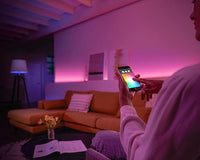Smart lighting automates your home by allowing you to turn lights on or off from anywhere using an app or voice command if you are at home. Simply put, smart lighting is the future.
Smart lighting control will highlight the charm of any residence, large or small, old or new. Several relatively inexpensive modifications will transform your existing lighting and switches into a smart lighting system.
Start with the lighting before proceeding to implement other smart home features. We offer lighting smart products at SMART HOME LABS that come in a wide variety of aesthetics and features, especially those that are easy to assemble and can be used with your existing lighting and switches. When you're just getting acquainted with your smart home, you'll have to commit to the switch if you're looking for an optimal level of comfort and effectiveness.
Plugging them into your sockets and downloading an app is all you have to do for some systems. Smart lighting is a more advanced method of gaining complete control over your electricity, both consumption, and utilization, with some specific perks that are exclusive to smart bulbs and smart light switches. A cost-effective and energy-efficient way of replacing incandescent bulbs is by switching to smart LED bulbs.
Smart Lighting: How to Get Started
You don't have to worry about a state-of-the-art whole-house automation upgrade if it's out of your budget or comfort zone. There are still ways to make your home smarter. Embrace smart lighting by following these simple steps.
Find a Good Assistant:
Lighting your house is a pretty basic thing to do. By flipping a switch, you can turn on or off the lights. Lighting has always been controlled through this no-frills method, but smart lights are changing how people work with their lights. This is extremely valuable if you will be using a smart speaker like Google Assistant or Amazon Alexa to control the lights.
Devices with voice activation can control a variety of smart lighting functions, including dimming, brightening, and turning lights on and off.

Smart Bulbs:
The simplest way to start exploring smart-home options is by changing your light bulb. Install a smart bulb, such as Witron's Smart Light Bulb at Smart Home Labs, into an existing fixture, connect it to your WiFi network, and experiment with using the app to control it. If you decide then, features such as brightness adjustment with a dimmer switch are worth further investment, you can go for it. However, if you have coloured LED bulbs, you can also adjust the colour.
Although smart light bulbs are sufficient for most people, there are other components to smart lighting that you should be aware of, such as smart switches. In terms of cost and setup, both have pros and cons. It is possible to use smart lighting products to do more than just reduce your energy bills and enjoy a well-lit home. Recent research shows that blue lighting negatively affects melatonin levels and sleep patterns. Smart lighting technology is almost universally compatible with smart lighting products, as we already stated.

Smart Switches:
Smart outlets and switches, such as the Witron Smart Touch WiFi Socket. Installing a smart switch will allow you to remotely control your fixtures, including those with basic bulbs. After experimenting with smart light switches, you might consider installing smart light fixtures, which are built with this technology and can be controlled via voice commands or apps.
It's easy to turn your "dumb" light switches into smart products, thanks to products like smart switches. Wireless switches can be integrated not only with bulbs but also with other devices, such as speakers or TVs. With a single switch, it will be easy to turn on the lights in the living room without fumbling with too many buttons and wires.

Connect Smart Lighting to your Home Network
Smart lights need to be connected to your home network via WiFi, Bluetooth, or another similar technology. With the included app, you can control the lights with your phone or tablet. Then open the app, find the light, and you're good to go.
Consider the technology your smart light uses. If it uses Bluetooth, for example, you won't be able to control it when you're away from home. WiFi enabled smart lights, on the other hand, can be controlled from anywhere as long as they are both connected to the Internet.
Lighting Controls That Let You Be Creative
When you use free web-based services to link smart lights with other smart devices, the possibilities are nearly endless. You can use your smart doorbell to turn on an outside light when someone rings it, turn on your bedroom light with the help of motion sensor. The capabilities of home automation can make your life easier if you're willing to explore them.
Create an automated lighting routine that works for you with this smart home lighting.

Conclusion
You can schedule a light wake-up call, establish a wind-down routine before bed, or control the lights remotely while on vacation with a smart light. In addition to remotely controlling the brightness and lighting in your home via an app or voice control, the technology also makes it possible to control your home's energy efficiency. Look at our collection of smart lighting products before switching from your basic bulbs to high-tech ones.


